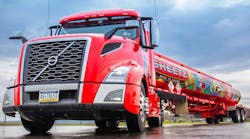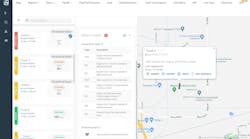HABIT #2 in Stephen Covey’s international bestseller, The 7 Habits of Highly Effective People, implores us to “begin with the end in mind.” That means beginning each task with a clear vision of the desired direction and destination, and then flexing proactive muscles to make things happen.
David M Mihalick, senior director of vehicle safety and regulatory compliance for Thor Industries, believes it’s a critical application for trailer manufacturers when it comes to complying with National Highway Traffic Safety Administration (NHTSA) requirements.
In his presentation, “NHTSA Requirements: The Deep Dive,” Mihalick said it’s important because the end could involve a lot of money. He spoke at the National Association of Trailer Manufacturers (NATM) Educational Workshop held in September 2016 in Elkhart IN.
“Let’s go back to 2014 and 2015,” he said. “2014 is when thing started heating up at NHTSA about finding issues. There was an ignition switch recall. GM got fined $35 million for failing to issue a recall in a timely manner, and it just gained momentum. People started asking questions. Dealers play a role in this. They have to be aware of what their responsibilities are when they sell your trailers. If it has a recall on it, they can’t do anything with that trailer.
“In 2015, it got really crazy. Companies were fined a total of $500 million. We had an industry member on the RV side who wrote a check for $6 million. 2016 has been pretty quiet. I think they got a lot of people scared.
“Now the fines have tripled. You can get fined $21,000 per incident per day. So if you have noncompliance on vehicles, each one of those vehicles by themselves would be considered an incident. It can go up pretty quickly. It gives them a lot more capability to impact somebody financially and get their attention.
“You don’t want to give anybody the ability to ask questions, if at all possible. Because if they ask questions, they won’t focus on just one item they find wrong. They will ask about a lot of other things at the same time.”
He said that as defined in USC 30102 (a)(5), “manufacturer” means a person manufacturing or assembling motor vehicles or motor vehicle equipment; or importing motor vehicles or motor vehicle equipment for resale.
“This definition becomes very critical to understand and comply with,” he said. “For OEMs and direct equipment suppliers, it is very clean and clear-cut. For those of you that are distributors, this becomes not so clear as you are a middle man. Please understand you have a role to make sure that the equipment manufacturer is aware that their products are being used in motor vehicles and they would be subject to the NHTSA requirements as a result. If it goes into the vehicle, they are included.”
Mihalick said there are two big parts of the law:
• Federal. That involves United States Code (Title 49, Chapter 301 of the Motor Vehicle Safety Act) and the Code of Federal Regulations (Title 49, Transportation, various parts, and Chapter V of NHTSA, DOT).
• State. Specific State Equipment Road Use Law (SERUL).
He said the majority are covered in Title 49 of the CFR. Chapter 301 authorizes NHTSA to regulate the industry by: issuing vehicle safety standards; requiring manufacturers to recall vehicles with a non-compliance or safety related defect; gathering information to conduct investigations; requiring manufacturers to retain certain records; and enforcing the rules and regulations, including seeking civil penalties.
He said 49 CFR Part 571 of the Federal Motor Vehicle Safety Standards (FMVSS) covers seven vehicle types: passenger cars, multi-purpose passenger vehicles, trucks, buses, trailers, motorcycles, and low-speed vehicles.
“There is a large difference in impact for trailers and motorhomes,” he said. “Motorhomes in most cases follow the IVD of the chassis supplier and create Type 1, Type 2, or Type 3 statement responses to the IVD. The main items: FMVSS 108 Lighting and FMVSS 110/120 Tires and Wheels.”
Recall management involves:
• 49 CFR Part 573 (Defect and Noncompliance Responsibility and Reports): “Letting NHTSA know about the issue.”
• 49 CFR Part 577 (Defect and Noncompliance Notification): “Letting your customers and dealers know about the issue.”
The facets of 49 CFR Part 573.3:
• Manufacturers. “Applies to manufacturers of complete motor vehicles, incomplete motor vehicles, and motor vehicle original and replacement equipment … that have been transported beyond direct control of the manufacturer.”
“The application of who does a recall can get tricky,” Mihalick said. “In the end, NHTSA wants to make sure the vehicle owner knows they have an issue. Sometimes this results in recalls that overlap.”
• Importers. “Motor vehicle or equipment item imported into the US. Compliance by either the fabrication manufacturer or the importer … shall be considered compliance by both.”
• Multi-stage manufacturers. “Exist in a vehicle manufactured in two or more stages, compliance … by either the manufacturer of the incomplete vehicle or any subsequent manufacturer of the vehicle shall be considered compliance by all manufacturers.”
• Replacement equipment. “Compliance … by the brand name or trademark owner shall be considered compliance by the manufacturer.”
• Equipment used by only one manufacturer. “Exist in an item of original equipment used in the vehicles of only one manufacturer. Compliance … by either the vehicle or equipment manufacturer shall be considered compliance by both.”
• Equipment used by multiple manufacturers. “Exist in an item of original equipment installed in the vehicles of more than one manufacturer. Compliance … is required of the equipment manufacturer as to the equipment item, and of each vehicle manufacturer as to the vehicles in which the equipment has been installed.”
• Dealers. “The provisions of 573.11 apply to dealers, including retailers of motor vehicle equipment.”
“This is a big one!” Mihalick said. “Dealers are part of the recall process. They can be fined and have been.”
There are four types of recalls issued by NHTSA: vehicle (16V-XXX); equipment (16E-XXX); tire (16T-XXX); and child seats (16C-XXX). All submissions are done online via the recalls portal: www.safercar.gov.
So what constitutes a recall action?
A safety defect is a two-step process:
• Is it a defect?
• Is the defect related to motor vehicle safety? Or more specifically, does the defect present an “unreasonable risk”?
“This is NHTSA guidance that needs to be interpreted by your individual organization,” he said.
In a recall notification to NHTSA (49 CFR Part 573.6), each manufacturer shall furnish a report to NHTSA for each defect in his vehicles or in his items of original or replacement equipment that he or the Administrator determines to be related to motor vehicle safety, and for each non-compliance with a motor vehicle safety standard in such vehicles or items of equipment which either he or the Administrator determines to exist.
Each report shall be submitted not more than five working days after a defect in a vehicle or item of equipment has been determined to be safety related, or a non-compliance with a motor vehicle safety standard has been determined to exist.
The report includes:
• Manufacturer’s name.
• Identification of vehicles or equipment involved.
• The total number of vehicles or items of equipment.
• A description of the defect or non-compliance.
• In the case of a defect, a chronology of the principal events leading to the determination of a recall.
• In the case of a non-compliance, test results and other information used to determine the non-compliance.
• A description of the remedy program to include reimbursement plans and timing.
• A representative copy of all notices, bulletins, and other communications that relate to the recall. Also see 49CFR Part 577.
“This information is provided on the recalls portal by the appropriate manufacturer,” Mihalick said. “Canada is manual paper submission.”
As part of 49 CFR Part 556 (Exemption for Inconsequential Defect or Noncompliance), notification is made at the time of Part 573 submittal on the Recalls Portal. The petition needs to be submitted that presents your case as to why this recall in inconsequential. The petition is posted in the Federal Register with a 30- or 60-day comment period. Petition disposition is decided.
49 CFR Part 573.7 requires quarterly reporting on the number of vehicles inspected and/or repaired as part of the recall campaign. It is submitted for six consecutive quarters via the Recalls Portal.
49 CFR Part 573.11 says that if notified of a safety defect or non-compliance, a dealer cannot sell a vehicle or equipment until that defect or non-compliance is remedied. They can still offer it for sale but just cannot sell it.
Part 573.13 defines requirements for pre-notification reimbursement and requires at a minimum one-year prior to the submission of 573.6 notice and 10 days after mailing of owner’s letters. A manufacturer can submit a general reimbursement plan to cover all their recall actions.
“This really comes into play on recalls that affect older units,” Mihalick said.
Talking about 49 CFR Part 577 (Defect and Noncompliance Notification), he said, “This part sets forth requirements for manufacturer notification to owners, dealers, and distributors of motor vehicles and items of replacement equipment about a defect that relates to motor vehicle safety or a noncompliance with a Federal motor vehicle safety standard. The purpose of this part is to ensure that notifications of defects or non-compliances adequately inform and effectively motivate owners of potentially defective or non-complying motor vehicles or items of replacement equipment to have such vehicles or equipment inspected and, where necessary, remedied as quickly as possible. It is also to ensure that dealers and distributors of motor vehicles and items of replacement equipment are made aware of the existence of defects and non- compliances and of their rights and responsibilities with regard thereto.”
49 CFR Part 574 (Tire Identification and Recordkeeping) provides the requirements for tire manufacturers to provide a Tire Identification Number (TIN) on each tire and requires vehicle manufacturers to maintain a record of each new tire on or in each motor vehicle shipped by him. These records need to be maintained for five years from the date of sale of the vehicle.
49 CFR Part 575 (Consumer Information) requires vehicle manufacturers to provide Uniform Tire Quality Grading Information in the owner’s manual of each vehicle it produces.
Talking about the Tire Identification Number (TIN), Mihalick said the DOT numbers only appear on one tire sidewall. This begins with the letters “DOT” and indicates that the tire meets all federal standards. The next two numbers or letters are the plant code where it was manufactured, and the last four numbers represent the week and year the tire was built. For example, the numbers 3197 means the 31st week of 1997. The other numbers are marketing codes used at the manufacturer’s discretion. This information is used to contact consumers if a tire defect requires a recall.
49 CFR Part 576 (Record Retention) has a basic requirement: Retain records for a period of five calendar years from the date on which they were generated or acquired by the manufacturer. This specifies all information reported in 49 CFR Part 579. Records include claims, complaints, reports, and other records concerning alleged and proven motor vehicle or motor vehicle equipment defects and malfunctions that may be related to motor vehicle safety.
“It should be expanded soon with rulemaking,” he said.
Manufacturers are expected to maintain any records including warranty, consumer complaints, field reports, etc, that might be related to defects on vehicles or equipment. In the event an investigation is opened on a defect concern, a manufacturer should have these records so that NHTSA can make an educated decision on whether or not a safety defect exists.
49 CFR Part 579.11-12 (Foreign Recalls and Other Safety Campaigns) says that manufacturers must report to NHTSA any order or decision to conduct a safety recall or other safety campaign in a foreign country that covers a motor vehicle that is identical or substantially similar to a vehicle sold or offered for sale in the United States. This regulation also requires manufacturers of motor vehicles to provide NHTSA with a list of substantially similar vehicles sold or to be sold in a foreign country. ♦










